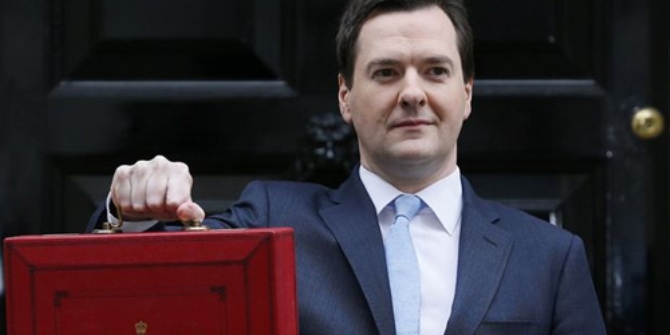Many comparisons have been drawn between Britain’s two female prime ministers, but Graham Goodlad explains that they governed in completely different contexts, even if their styles shared similar elements. In answering whether Theresa May is Thatcher’s ideological heir, he goes beyond the superficial similarities and considers their social, economic, and foreign policies.
Britain’s first two female prime ministers shared a number of superficial similarities beyond their gender: both were hard-working, serious individuals from modest, aspirational backgrounds. Both possessed autocratic temperaments. Nonetheless we need to beware of drawing over-simplistic parallels. May herself once warned against ‘lazy’ comparisons with her predecessor.
In comparing the two leaders, we need to remember the very different contexts in which they operated. The 1970s and 1980s had a very different feel from the second decade of the 21st century. Modern political culture is much more fluid, more cosmopolitan and globalised. Theresa May became Prime Minister following her predecessor’s unexpected resignation and the implosion of her main leadership rivals, at a time of acute national and party divisions. The issues facing Thatcher when she won the 1979 election were very different, and leaving Europe was not on the agenda.
The political fortunes of the two prime ministers have also been sharply divergent. Thatcher won three decisive majorities and was weakened only near the end of her long premiership, whereas May now struggles with her government’s minority status as well as the unprecedented complexity of Brexit.
Both premiers could be ruthless in their treatment of Cabinet colleagues, as shown in the signals given by the sackings of Francis Pym (1983) and George Osborne (2016). Thatcher and May have followed the post-1945 tendency to take key decisions in Cabinet committees and have governed with a core of trusted senior colleagues – Damian Green and David Lidington have been likened at different times to Willie Whitelaw.
Both prime ministers have been accused of depending on unelected advisers: Thatcher’s fateful reliance on Professor Alan Walters bears comparison with May’s association with her unpopular joint chiefs of staff, Nick Timothy and Fiona Hill, before the 2017 election. Both leaders have had to manage contending Cabinet factions, although Thatcher became more independent with the passing of time. May still has to balance Remainers and Brexiteers, and powerful colleagues have more opportunity to constrain her freedom of action.
So, is Theresa May a ‘Thatcherite’? We will briefly examine three areas – social, economic and foreign policy – in assessing how far May is truly Thatcher’s ideological heir.
May, Thatcher, and society
May’s well-known 2002 ‘nasty party’ speech, as Conservative chairman, was a way of distancing the party from the politically toxic memory of social division under Thatcherism. She was socially progressive enough to accept same-sex marriage – a far cry from Section 28 of the 1988 Local Government Act. May has also been more active in promoting women’s interests, supporting the adoption of female Conservative parliamentary candidates through the pressure group Women2win, in a way that Thatcher never did. While Thatcher notoriously appointed just one woman to her Cabinet, four full members of May’s Cabinet are female and until April 2018 the Home Office was held by a fifth woman, Amber Rudd.
Economic policies
Thatcher emphasised the moral value of the free market and of personal independence in a way that May has not done. She has spoken of making Britain ‘a country that works not for a privileged few but for every single one of us’. The 2017 Conservative manifesto condemned, in a wholly un-Thatcherite phrase, what it termed ‘the cult of selfish individualism’. True, she has defended capitalist values against Labour Party criticism. In January 2018 she struck a Thatcherite tone when Jeremy Corbyn tried to use the collapse of construction and outsourcing firm Carillion to make a wider political point, responding that ‘what Labour oppose isn’t just a role for private companies in public services, but the private sector as a whole.’
Yet May’s philosophy is unquestionably more interventionist than Thatcher’s. At the 2016 party conference, she stated that ‘where markets are dysfunctional, we should be prepared to intervene’ and reminded her audience of ‘the good that government can do’. Her 2017 manifesto proposed an energy price cap which was strikingly similar to Ed Miliband’s policy two years earlier, denounced at the time by the Conservatives as an example of misguided socialist interference in the market.
The wider world
The coincidence of having, from January 2017, two right of centre leaders in London and Washington, one female, the other male, prompted simplistic parallels with the Thatcher/Reagan relationship. In practice, however, May and Donald Trump have not recreated the personal chemistry of their predecessors. Trump’s unpredictability, his tendency to comment on the internal affairs of allies, and his isolationist and protectionist instincts are obstacles to a close transatlantic alliance. The postponement of Trump’s visit to the UK until July 2018 was another indicator of a weakened relationship.
Finally, how are we to assess Thatcher and May in relation to Europe? We cannot know which side Thatcher would have taken on the 2016 referendum. In her final book, Statecraft, she argued that Britain should contemplate leaving the EU if it could not obtain better terms for its membership. Yet this was written deep into her retirement. Charles Powell, her closest foreign policy adviser, insisted that had she been in charge, she would have done as Cameron did – seek a renegotiation and then campaign to remain. This was essentially May’s position at the time of the referendum. There has been continuity in their broad approach: trying pragmatically to protect British interests, whilst criticising the alleged growth of an EU ‘super-state’.
Conclusion
Beneath the superficial similarities there are important contrasts between the two leaders. Thatcher was not as inflexibly ideological as some have portrayed her, but she certainly had divergent social attitudes and political priorities from May. This can partly be attributed to generational differences. Nor has May aroused the extremes of adoration and loathing associated with Thatcher. Although Thatcher was harshly caricatured, she was almost always depicted as a dominant figure, quite unlike the hapless ‘Maybot’. In politics, it is much harder to survive people’s scorn than their hatred.
__________
Note: the above draws on the author’s article in Political Insight.
Dr Graham Goodlad is Head of Politics at St John’s College, Southsea, and author of ‘Thatcher’, published by Routledge in 2015.
All articles posted on this blog give the views of the author(s), and not the position of LSE British Politics and Policy, nor of the London School of Economics and Political Science. Featured image credit: Portrait of Theresa May shared under an Open Government Licence v3.0; Portrait of Margaret Thatcher shared under a Creative Commons Attribution-Share Alike 3.0 Unported license.







